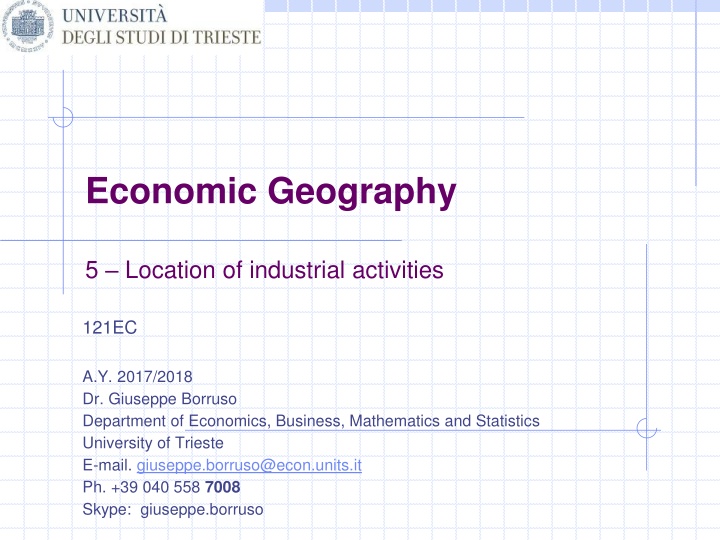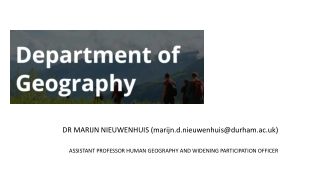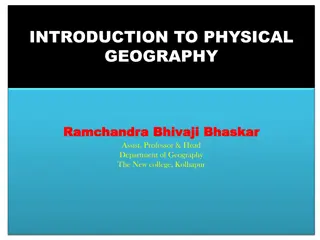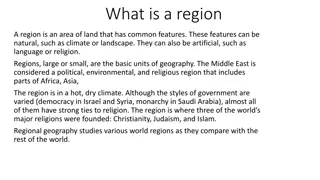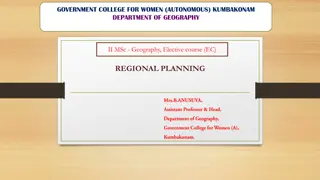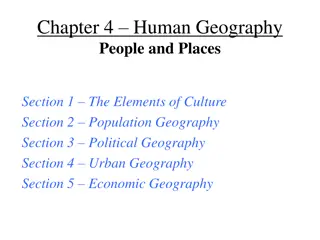Economic Geography
Industrial geography examines the factors influencing the location of industrial activities and the evolution of industry through historical revolutions. From the first industrial revolution to the rise of hi-tech and cyber-physical systems, explore the spatiality of industrial clusters, production processes, and key industry categories.
Download Presentation

Please find below an Image/Link to download the presentation.
The content on the website is provided AS IS for your information and personal use only. It may not be sold, licensed, or shared on other websites without obtaining consent from the author.If you encounter any issues during the download, it is possible that the publisher has removed the file from their server.
You are allowed to download the files provided on this website for personal or commercial use, subject to the condition that they are used lawfully. All files are the property of their respective owners.
The content on the website is provided AS IS for your information and personal use only. It may not be sold, licensed, or shared on other websites without obtaining consent from the author.
E N D
Presentation Transcript
Economic Geography 5 Location of industrial activities 121EC A.Y. 2017/2018 Dr. Giuseppe Borruso Department of Economics, Business, Mathematics and Statistics University of Trieste E-mail. giuseppe.borruso@econ.units.it Ph. +39 040 558 7008 Skype: giuseppe.borruso giuseppe.borruso@econ.units.it
Learning Objectives In this lesson we will: Introduce the industrial location s factors; Examine the spatiality of location factors; Focus on: industry clusters (industrial districts); Present Weber s theory of industry location
Topics 1. Industry: characteristics 2. Factors of industrial location 3. Insight: diffusion processes 4. Geographical production factors Industry clusters The Silicon Valley case 5. Industrial location theory 1. 2.
Industry: characteristics Industrialization is an essential aspect of World Economic Growth Dimensions, transformation of spaces, impact on economies, effects on development and lifestyles. Industry: from manifacturing to trivialization : from the secondary sector to (almost) every production type
Industry. Production systems Vertical Production processes linked together in line Transformation of raw materials in a final product (i.e., steel industry) Orizontal lateral Differentiate productive processes To converge in an assembly industry (i.e., automotive) Services Production processes of services, organized by other operators (i.e., energy supply, transport infrastructure)
Industry. Main categories Mining industry (basic) Manifacturing (processing) Construction Energy
Industry. The revolutions I industrial revolution England (XVIII start XIX Century ). Steam machine (James Watt, 1783). Coale; iron; textiles New organization of labour (it substitute the makers model) Countryside City movements and migrations II industrial revolution End XIX Century - Beginining of XX century Coal -> Oil, hidroelectrig energy New industries, new locations, new markets, new products. Series production. Fordism III industrial revolution End of XX century To-date Hi tech: electronics, robotics, telecommunication, bio-tech IV industrial revolution Cyber-physical systems Makers Circular economy 3D Printing
Industrial location Spatial distribution and location of industries: Inserting a manufacturing firm in a given territory is important in terms of the spatial reorganization of: Demographic component; Urban structure; Other economic activities; Network of flows and traffic; Political- social rules. Industrial geography: where and why industries in a given territory => location as a process of setting an industry. It is important to examine: The factors of industrial location; The geography of production factors; Location theories
Industrial location Geographical studies on the spatial distribution and location of manufacturing activities; Factors of industrial location; Geographical production factors; Land Capital Labor Information Scale, manufacturing relocation and spatial concentration Industrial location theory Weber, Smith Hoover, Palander
Industrial locations factors Natural elements Environment influences location Industries influence environment moving resources and technologies (i.e., water) Industry-nature relationship (externalities) Technical factors Energy supply; Organization of transport systems; (technological changes make the location issue a more elastic one) Demographic factors Population-industry relationship Population = demand of products; = workforce supply Expected demographic dynamics and socio- economical qualities (gender, age, education, etc.) Historical-cultural factors endogenous culture of a territory: pre- industrial organizational production often put he basis for future industrial setting. (industry not always an element of break with territory) Economical factors More complex ones and directly related to the nature of the production activity Capital, work, land+ knowledge (entrepreneurship and managerial education) Psycho-social factors Non-objective elements of territory; Actors and strategic choices: relocation; delocalization, multi-localization The cognitive and perceptive behavior of the company s decision maker is relevant Relevant the environmental amenities Knowledge or perception of the competitors spatial structure Political factors Regional economical development Political target = avoid interregional imbalances deriving from a high industrial concentration (spatial planning => capacity of intervention over different aspects concerning a territory s organization)
Spatiality of production factors Economics analyzes scarcity, remuneration, accumulation of production factors; Spatiality (spatial dimension) Land Capital Labor Information Entrepreneurial and managerial culture, innovation capacity
Spatiality of production factors Land: Location (space) Physical support to the social organization (territory) Container of renewable and non-renewable resources (environment) Accessibility (transport) Physical location of industry Competition with other human activities; Preference for flat lands; water; waste disposal Land <> climate (advantages of setting in certain climate zones) Land vs territory (space transformed by work: cities and communication networks) Land as set of renewable resources
Spatiality of production factors Capital: Usually considered mobile and non spatial Technical component of capital is located in the existing production places => places where investments for innovation and modernization will be directed (capital intensive structures) Financial capital in a free market chooses the areas in which a stable development is present (reduction of uncertainty) Consequences on the capital s costs (interests) => financial instrument used as regional development policy Bank system and location of credit management structures
Spatiality of production factors Labor: Production factor whose supply is more uniformly distributed in space Historical empirical evidence: long range migrations towards places of high workforce demand From a qualitative point of view, work is not mobile in space (related to a given territory) Labor is not related to the regulation of markets as it is an element of spatial organization and at the same time oriented and qualified by place. Economic neoclassic theory: Labor = undifferentiated set and production factor expressed by its price (without considering the social context) => a-spatial hypothesis : 1. Employers and employee hold a satisfactory knowledge of employment and wages thanks to the market; 2. Individuals are rational (maximization of profits and wages) 3. Individual decisions are not influent over the general level of wages 4. There are no obstacles to the mobility of labor 5. Labor = exchangeable and homogenous in every particular market
Spatiality of production factors Labor: It s a living production factor, not just a SIMPLE input Worker = carrier of a cultural process deriving from the environment Labor = pseudo-commodity Labor is crucial in location. The cost of a unit of labor increases more than the average of the production costs. Location processes and production conversion: 1. Industrialization in new countries (NIC new industrialized countries) having a low cost of the workforce 2. Specialization of the countries of old industrialization in sectors producing capital-goods and non standard consumption goods and dedicated to selected and non- fragmented market shares.
Spatiality of production factors Information: Technical knowledge (know how) Network of centres Network of the existing industrial development Entrepreneurial innovation Research and development Innovation diffusion Filtering down Learning by doing Learning by seeing Telematics - ICT Political economical information Role of capital cities in industrial location (es. Rome after Milan and Turin)
Industry: Scale, production decentralization, spatial concentration Location choices and production scales Optimal dimension: production techniques in the different industry branches Steel industry integrated cycle; automotive; Production place <= external to industry environment (physical and human resources) Emphasis on the market: large vs small (residual) enterprises; Objection = existence of spatial systems of small and medium enterprises: High competition; Economies of agglomeration; Specialization of the different phases and stages; spread manufacturing (see industry clusters)
Industry: Scale, production decentralization, spatial concentration Tani (1987): Relationship between technological development, market dimension and economic production scale does not necessarily imply bigger dimensions of single production units: Technical de-construction of the production process: 1. By means of the organization of the same firm in parallel lines; 2. Decentralization of some of the production stages outside the company / firm (productive decentralization); 3. Organization of a system of firms / enterprises geographically contiguous and functionally integrated in small and medium enterprises (industry cluster).
The recombination of the production process Phase D Phase A Phase F Phase C Phase B Phase E Phase D (n=4) Phase A (n=3) Phase F (n=1) Phase C (n= 7) Phase B (n=2) Phase E (n=5)
The new model of industrial production Centre Semiperiphery Periphery Strategic decisions Research and development Production Big manifacturing Sales Production Strategic decisions Research and development Sales Multinational Firm Sales Production Sales Production Sales Strategic decisions Transnational Manifacturing Research and development Sales Production Sales Legend Delocalized Activity Juridical framework Business relationship Decision maker
The product lifecycle No change No change process Innovation Components substitution Low complexity change Product improvement Medium complexity change New product radical change Improvement of exhisting process New generation process New process No change Innovation s product Product s lifecyclce
Factors influencing the products lifecycle Rate of product s sales Time Capital Capital Capital External Economies Importance of elements External Economies External Economies Non specialized workforce Non specialized workforce Non specialized workforce Know-how Know-how Know-how Management Management Management Stage 1 Stage 2 Stage 3
Products lifecycle and spatial diffusion Product s ratio of sales Time Production
Factors and spatial diffusion Capital Capital Capital External Economies Importance of elements External Economies External Economies Non specialized workforce Non specialized workforce Non specialized workforce Know-how Know-how Know-how Management Management Management Stage 1 Stage 2 Stage 3 Production
Spatial diffusion In geography we highlight two macro types of diffusion: Diffusion as relocation (original location is abandoned: migrations; industrial re-location); Diffusion as expansion (sprading from one place to another one): Contagion (direct contact: epidemics; economic crisis); Hierarchical or waterfall different steps or stages: example - innovation). Bottom up Top down (diffusion follows
Spatial diffusion - Expansion (a) - Relocation (b) - Combined effects of expansion and relocation (c) and (d)
Spatial diffusion: modes Principle of non-spatially dependant Hierarchical diffusion at successive moments of time Typical successive stages of diffusion rate during the diffusion process. For an innovation, they are called Innovators, Early majority, Late majority and Laggards Case study: Spatial diffusion in music https://www.youtube.com/watch?v=_euGMuX8EG8
Industry Clusters 1st law of Geography (Tobler, 1970): Everything is related to everything else, but near things are more related than those far apart (distance decay effect) => very few of us live in complete isolation from the rest of society. It is likely that many of our behaviours, choices, aspirations and ideals are influenced by those with whom we interact in our everyday lives.
Industry clusters Clusters illustrate why place still matters in the global economy. Michael Porter defines clusters as groups of similar and related firms concentrated in a small geographic area (Porter, 1998). interconnected firms in the same fields, specialized suppliers, service providers, firms in related industries, associated institutions (such as trade associations, universities, technology transfer centers, etc.).
Industry clusters (Industrial districts) Industry clusters are geographic concentrations of competing, complementary, or interdependent firms and industries that do business with each other and/or have common needs for talent, technology, and infrastructure. The firms included in the cluster may be both competitive and cooperative. They may compete directly with some members of the cluster, purchase inputs from other cluster members, and rely on the services of other cluster firms in the operation of their business. Industry clusters are dynamic entities. They may change as the industries within them change or as external conditions change An important characteristic of clusters is that they are centered on firms that sell outside the local, state, or even national market Clusters may include government, nonprofit organizations, educational institutions, and other infrastructure and service providers whose presence is key to the strength of the cluster. An industry cluster is an interconnected group of industries and firms. It differs from trade associations, which may have a narrower membership and focus. A trade association, for example, may include the members of a single industry and focus entirely on lobbying. By contrast clusters are agglomerations of regional industries and interdependent firms that are key to the success of the industry in the state. Organized industry clusters contribute broadly to the well-being of the region by addressing workforce recruitment and training issues, developing needed infrastructure, and establishing research and training programs at universities and technical colleges, to name a few.
Industry clusters (Porters definitions) [ clusters are] a geographical concentration of firms interconnected by being part of the same industry or the same supply chain, by a common resource or market, by similar philosophy, by facing similar opportunities and challenges or by collaborating with the same university or research institution 1 Michael Porter Diamond of Advantage , a model that offers insights into industry clusters and competitiveness: regions develop a competitive advantage based on their firms' ability to continually innovate, and that economic vitality is a direct product of the competitiveness of local industries. [1] Michael E. Porter, Clusters and the new economics of competition, Harvard Business Review, 1998
DEFINITION AND ADVANTAGES Lower inputs and transaction costs; High quality information at lower cost; Higher level of trust; Skilled labour force. Set of enterprises competitive or cooperative, which produce and sell related products, facing common challenges and opportunities.
EFFECTS ON ENVIRONMENT 1. Increase productivity way in which companies compete; 2. Benefits on innovation; 3. Creation of new businesses.
Industry clusters: factors innovation and growth The factors that drive innovation and a cluster's growth include: FACTOR CONDITIONS: such as a specialized labor pool, specialized infrastructure, and sometimes selective disadvantages; HOME DEMAND: or local customers who push companies to innovate, especially if their needs or tastes anticipate global or local demand; RELATED AND SUPPORTING INDUSTRIES: nationally competitive local supplier industries that create business infrastructure and spur innovation and spin off industries; INDUSTRY STRATEGY, STRUCTURE AND RIVALRY: intense rivalry among local industries that is more motivating than foreign competition, and a local "culture" that influences individual industries attitudes toward innovation and competition government and chance. Historical accident and/or government actions tend to play significant roles in the development or location of industry clusters.
Industry clusters (Marshall definitions) Location variables (Marshall): Decreasing transport costs (not relevant in location) and spatial specilisation processes; Geographical, historical political, psychological factors; Localized economies: know how diffusion and capacity; Innovations and findings continuous through time; Trade and transport system development; Face to face agreement; Complementariety between industries specialized in terms of stages / phases (process) or types (of product); Enlarging specialized labor market (immigrant) Attracting entrepreneurial capacities. Marhsall s analysis considers firm as homogeneus or specialized BUT capable of being extended to different industries - external economies, and complementariety of the job market and consolidated on the demand of goods) Marshall does not analyse the work in means of developing activities Marshall admits the possibility of congestion diseconomies.
Industry clusters (Industrial districts) Marshall (1920) identified the firm s external economies, although internal to the district, the basic foundations' of the distrcts (or local labor systems) competitiveness.. The spatial aggregation of several firms, each one operating in full technical and organizational efficiency, related in terms of production and distribution processes, determines a particular efficency condition for the overall economic system. Economical advantages: Reduction of production costs; Reduction of transaction costs; Innovative and incremental dynamics settings. The environment allows an organization based on a non- hierarchical order. The spontaneous and self propelling character in producing external economies seems to originate from evolutionary stability and by the convergence of a set of socio-economical, institutional and manufacturing.
Industry clusters (Industrial districts) Technological conditions: Economies of scale relevant at plant level and not firm s one; Technologies having minimal efficient dimensions at local, limited- production scales; Spatial concentration of the manufacturing relations among specialized companies. Market conditions A growing market Standardized growth of the market and of the related specific manufacturing techniques Lack of substantial changes within the market relationships Firm s external economies: Economies external to firms but internal to local community; spread, as not appropriable individually by a single player; Localized, as belonging to firms rooted there; Localizing, as few and maintaining relations between neighbouring companies; Influenced by technological, market, socio-economical and geographical aspects; External economies are generated unocunsciously through the operation of other different local actors payers within the district.
Clusters Vs Industrial Districts CLUSTER Less defined boundaries INDUSTRIAL DISTRICT More defined boundaries Wider space Smaller space Heterogeneity In products and sectors Homogeneity 42
Evolution of the Concept of cluster 1890 1980s 1950s 2000s 1990s Marshallian Industrial Districts New Industrial Spaces Industrial Clusters & Clusters Industrial Location 3 Economic Agglomerations: - Of localization - Of urbanization - Internal returns to scale Italian Industrial Districts Regional Innovation System
HOW CLUSTERS EFFECT COMPETITION Driving the Stimulating the formations of new business Increasing productivity Add title here direction and pace of innovation Add title here
The Cluster Life Cycle (2) 1. Emergence: there are few firms pioneering a new product, technological path or even a completely new industry and therefore have the push to innovate even though competition is not fierce yet. At this point we don t have a cluster yet, as only when the firms start to interconnect and create synergies we can start talking of clusters. This may or may not happen due to several factors, for instance the absence of supporting research institutions or the fact that firm simply develop very different cultures and take different technological approaches. 2. Growth: if technological trajectory homogeneity is achieved and spin-offs from the original firms occur, the cluster becomes more definable, and heterogeneity decreases. 3. Sustainment: the cluster enjoys stability of interconnection and the spread of technology is even among firms. This is a phase of stagnation. 4. Decline: the cluster faces a decline in the number of firms and an increasing number of mergers and acquisitions, capital moves away from the area and start- ups formation is close to zero. 46
LIFECYCLE BEGINNING multiple causes; DEVELOPMENT on average 10 years to gain competitive advantage; responses from institutions; rivalry; DECLINE internal or external factors.
Industry clusters (Industrial districts)
Focus on: THE SILICON VALLEY CLUSTER 49
